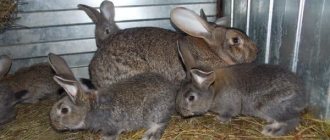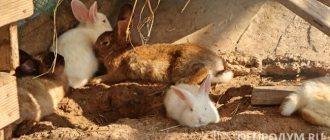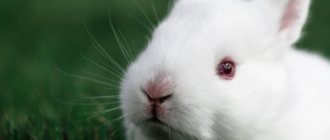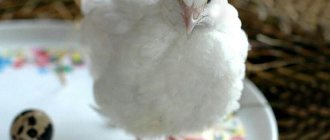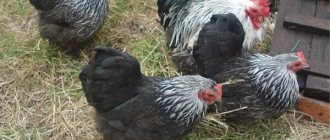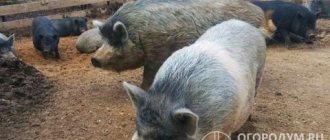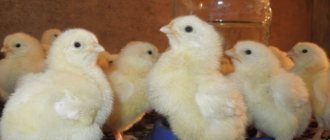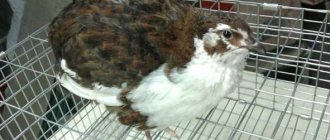Despite the wide variety of breeds, Butterfly rabbits are considered especially popular and beloved among farmers. It is distinguished from other breeds by its bright and unusual coat color, thanks to which it attracts the attention of both professional rabbit breeders and ordinary pet lovers. Butterflies are bred for their juicy meat and valuable fur, while many farmers consider them unpretentious to keep. Read more about breeding features, characteristics of available breeds, and vaccination principles in our article.
The main feature of the Butterfly breed is its unique and inimitable signature fur pattern, thanks to which they cannot be confused with anyone. It is distinguished by its white coloring with bizarre black spots, located sequentially in rabbits in clearly defined places, reminiscent of a butterfly. This feature makes them one of a kind. When examined closely, these graceful color patterns are a natural combination of white fur and black spots, although others do exist, such as blue and brown spots. Moreover, on the head and sides, as a rule, the tone is quite a bit darker than on the body.
In addition to the signature color, Butterfly fur is very pleasant to the touch, has the necessary thickness and elasticity, which is so necessary when making high-quality fur clothing.
Description and characteristics
Having carefully looked at the animal, an outside observer involuntarily catches its resemblance to a butterfly.
Appearance
Symmetrical spots located on the sides of the body and on the muzzle, together with a longitudinal jagged stripe on the back, create the effect of butterfly wings, as well as the black pattern on the nose. There are certain requirements for the color of the skin. The body is slender and strong, long strong legs, the croup is wide and round in shape.
Color and its varieties
The spots on a rabbit's skin do not have to be black. They can be brown, blue. The larger the rabbit, the less clearly defined the boundaries of the spots. Do not confuse rabbits of other breeds with spotted skins with butterflies. Among butterflies there are individuals with spots of 3 colors at once: yellow, brown and black, but there are not many of them.
Productivity
- Butterfly rabbits provide a large amount of tasty and tender meat. From one rabbit you can get up to 4.5-5 kg.
- The female brings up to 8 rabbits. She has a well-developed maternal instinct, so the rabbits basically all survive. In a year, a breeder can get a very good offspring.
- Butterflies make excellent skins that look great in their natural state. They don't need to be painted. And if you consider that the spots can be yellow or blue instead of black, then you can make so many beautiful things from this splendor!
History of appearance
In the 19th century, the British developed a unique breed of rabbits called the Butterfly. This was the result of an interesting and unusual color, reminiscent in appearance of a butterfly with open wings. At that time, the weight of one animal was more than 3 kg.
Over time, breeders from different countries continued their work based on the dwarf Butterfly breed. Geneticists have carried out painstaking work to correct the decorativeness of the breed and increase the weight of the animals, while simultaneously improving the quality of the fur.
It was necessary to adapt the animals to living in more severe climatic conditions. For this purpose, crosses were carried out with rabbits of the Viennese Blue, White Giant, Soviet Chinchilla, etc. As a result, animals were obtained whose weight could reach 5 kg.
Butterflies gradually moved from the decorative category to the number of meat-hide breeds.
Flaws
The disadvantages of this breed include:
- The inframammary area of the body is too massive.
- When crossing with other breeds, the quality of the skin noticeably suffers: spots on the back and sides may disappear, the longitudinal stripe may disappear, the skin will be less thick and attractive.
- Females are big gluttons, and if something doesn’t suit them in their diet, or they don’t have enough water, they can eat newborn rabbits.
Despite the fact that butterflies have a well-developed maternal instinct, young females can “not care” about their responsibilities. In this case, it is better to transplant the rabbits to a more “responsible” mother.
Owners' opinions
Pet owners admit that the cutest and most spontaneous creatures are decorative rabbits. Reviews about all breeds sound in a purely positive manner:
the animal fits perfectly into the family and becomes everyone's favorite
However, care must be taken when there are small children in the house, it should not be squeezed or pulled; decorative breeds of rabbits look like soft toys, especially when they are small. They are so unpretentious that they are suitable even for workaholics; This is a very smart animal, if you work with it from a very early age, it can even perform some tricks.
Maintenance and care
Since dwarf and ordinary butterflies cannot be called picky, keeping these beautiful fluffies is not difficult for novice rabbit breeders. Breeding - yes, since this issue requires certain knowledge and skills.
Content Features
Breeders keep butterflies in aviaries, shedens, pens, and cages. The best option is a cage. The butterfly rabbit is in full view of the owner all the time, you can monitor his well-being, control the processes of mating and gestation of the rabbits.
The cage should be regularly ventilated, but not exposed to drafts—the animals really don’t like them. If possible, the cage can be kept outside in late spring, summer and early autumn, and brought indoors in winter. This will only benefit the ears. Their coat will become thicker and shinier, their appetite will be excellent, and, consequently, the amount of meat will increase significantly. It is necessary to ensure that the butterflies in the cage always have fresh solid food on which to “sharpen” their teeth. In their absence, the rabbits' interest will switch to the rods from which the cage is made.
Feeding
Even a dwarf butterfly rabbit, even its larger brother, should have a wide variety of food. It must contain:
- green, slightly withered grass - in summer;
- fragrant, fresh hay - in winter;
- tree branches;
- grain feed;
- during the fattening period, concentrates can be used;
- Necessarily - mineral supplements and vitamins.
There should always be sufficient clean water in the cage. If you don’t keep an eye on this, you shouldn’t be surprised that the fledgling female ate her own little ears. She was thirsty, but she didn’t care about realizing her motherhood. In order for rabbits to feel good and gain weight quickly, you must adhere to the following rules:
- When selecting food products for animals, carefully inspect them for the presence of spoiled, rotten or beginning to deteriorate food.
- The dwarf eared rabbit, just like a regular butterfly rabbit, should be fed at least 2 times a day. It is advisable to do this at the same time.
- Green food must be given in summer.
- You need to keep the cage clean: change the bedding every few days and clean the feeders daily.
- The cage should always be dry. The main cause of death for rabbits of all breeds is dirt and dampness.
Although the butterfly rabbit is a productive meat breed, some breeders keep them at home as pets. And if treated well, the “dandy” butterfly can live up to 5-7 years.
Preventive measures
The first vaccination for butterfly rabbits is given at 6 weeks. But before this, be sure to check for the presence of worms 10 days before the dwarf and regular eared animals of this breed and, if necessary, deworm them. Rabbits need complex vaccination at the age of 1 year. Breeding butterflies involves the moment when females are not vaccinated during pregnancy and lactation. Sick rabbits are also not given the vaccine.
Weakened pathogens of myxomatosis and hemorrhagic diseases, entering the rabbit’s body, force it to produce its own antibodies against hostile cells. And the body of females and sick eared cats is already subject to heavy stress. Therefore, a different time is chosen for vaccinations.
Feeding
Rabbits Butterflies are unpretentious in matters of feeding and do not cause much difficulty. They quickly get used to the regime, so they should be served food at the same time. It is recommended to feed them twice a day - morning and evening.
Feed has a significant difference in winter and summer. In any case, you should follow the rule - you should not give wet, freshly cut grass. It needs to be dried and slightly dried. In cold weather, a special hay barn installed in a cage should always contain hay prepared in advance.
There are also foods that are not recommended for rabbits, especially in large quantities. For example, cabbage can cause digestive upset in rabbits.
The diet of rabbits should be complete and balanced. You can supplement it with purchased feed in the form of granules. It must be marked that it is intended specifically for feeding rabbits. For example, feed intended for birds contains small shells that can injure the delicate esophagus of rabbits. There are some differences depending on the age of the rabbits, as well as for pregnant females.
In the first time after birth, the only food for little rabbits is their mother's milk. This is a great success, since rabbit milk contains all the components necessary for a growing body. It is nutritious and high in calories. Females of this breed have a well-developed maternal instinct and there are no problems when feeding young animals.
After a certain time, you should begin to accustom the animals to adult food, but do this slowly. Each new product should be introduced separately, starting with small portions. In this case, the owner needs to monitor the condition of the animal. In case of negative manifestations, the serving size of the new product must be reduced or stopped altogether.
It is necessary to ensure that spoiled foods do not get into your food. You cannot give something that the owner himself probably likes, namely various sweets, sugar, chocolate. But carrots are always a welcome treat for rabbits.
Rabbits, which are rodents, have one peculiarity - their teeth grow very quickly. Nature has provided for the need for their regular grinding. To do this, in any season, it is necessary to hang branches of trees and shrubs on the wall of the cage, with the help of which the rabbits will satisfy this need.
It is also necessary to remember the danger of dehydration, which is difficult to tolerate. It can cause great damage to the animal’s body, even leading to a sad outcome. Therefore, there should always be drinking bowls with fresh drinking water in the cages.
Reproduction
Females are fertile and milky; In addition, they take care of their offspring. One litter brings an average of up to 8 cubs. Pregnant rabbits require adequate nutrition and rest. Pregnancy lasts up to 32 days, which she spends separately from the male. A few days before the birth of the offspring, it is advisable to disinfect the cage. In winter, the temperature in the cage should not be less than +6° C. As a rule, the female prepares the nest, covering the bottom of the cage with her own down.
Birthing usually occurs at night and lasts from 15 to 60 minutes. It is advisable for the owner to be nearby during this period. Rabbits are born bald and blind. After giving birth, the new mother licks her babies, feeds them and covers them with fluff.
After giving birth, the female wants to drink, so it is necessary to leave her enough water.
After 20 days, the rabbits can be gradually introduced to adult food, and from the 45th day they can be transferred to general food. From this time they are separated from their mother.
Currently, no work is being carried out to improve the breed. Crossing “butterflies” with other species is fraught with deterioration in the quality of the meat and a change in the color of the fur.
Crossing with other breeds does not benefit “butterflies”.
Breeding at home
Sexual maturity of individuals occurs at three months. By four months, the animal’s weight is 4-5 kg. The size of the cage must be at least 50x70 cm with a specially designated area for walking and shelter. For pregnant females, the size of the cage should be at least 50x100 cm, height - at least 50 cm. A queen cell is prepared for them, in which the cubs will subsequently appear.
It is important to vaccinate individuals in a timely manner according to a specific schedule.
10 days before vaccination, deworming is done. The first vaccination is carried out after 6 months. A comprehensive vaccination should be given annually. The time interval between the complex vaccine and other vaccinations is at least 14 days. During this period, the vaccinated animal is isolated from the rest. Vaccination is contraindicated for sick animals, pregnant and dairy rabbits.
Advantages and cost of butterfly rabbits
Nowadays, on industrial rabbit farms, the butterfly is increasingly replacing the giant and flander breeds, which produce more meat and skins. But it is still profitable to breed them at home. The original color of the skin makes it especially valuable. Butterfly meat is tasty, and in some respects it is superior to meat from other breeds.
How much does a breeding rabbit butterfly cost? The price in Ukraine for an adult rabbit for breeding is 400 hryvnia. You can find individuals cheaper, for 100-150 hryvnia, but they are not always purebred. In Russia, a butterfly can be bought for 1200-1500 rubles, or 300 rubles per kilogram of live weight.
How is the birth going?
If a breeder has purchased purebred Butterfly rabbits, it is highly not recommended to breed them with other species. Yes, this can increase the weight of the resulting animals, but it also sometimes spoils their coat beyond recognition.
Birthing always takes place at night and lasts from 15 minutes to an hour.
During pregnancy (it lasts 30-32 days), the female is provided with increased nutrition. She also needs vitamins to keep her body in optimal condition. 9-12 days before birth, the cage is completely disinfected. About a week before giving birth, the female begins to build a nest by plucking the fur on her belly. If she does not do this, you need to arrange the nest yourself; for this, similar material is used.
Birthing always takes place at night and lasts from 15 minutes to an hour. The longer the labor, the less likely it is that all the offspring will be born alive. Therefore, breeders often help the female, but to do this they need to call a veterinarian. The presence of water in the cage during childbirth is mandatory, because the female experiences extreme thirst after giving birth.
Rabbits of the Butterfly breed usually give birth to 8 rabbits, and only with poor feeding or maintenance does the number decrease. The female rabbit carefully monitors the newborns, licks them, covers them with fur, and takes care of them, so there is no point in taking the babies away. She has enough milk; the breeder is only required to monitor the health of the young animals and their mother, as well as feed everyone on time (additional feeding if necessary).
Rabbits are born blind and bald, but they develop actively. On day 20, they can begin to be given regular food, but only in small quantities and only gradually, in order to understand the characteristics of each animal’s body for a particular product. From the 45th day they completely switch to the diet for adult animals. At 3 months they already reach sexual maturity.
conclusions
- Rabbits of the Butterfly breed are not only attractive in photos, but also undemanding in care and maintenance, which is why they are widely used in many farms.
- Not every spotted hare is a Butterfly. The main distinguishing feature is the symmetry of the spots, but there are other signs. You need to pay attention to them when purchasing individuals.
- For breeding in order to obtain high-quality fur, only purebred individuals must be allowed to mate.
Demand for the breed
"Butterfly" is one of the most popular breeds of rabbits. The large variety is successfully bred to produce high-quality meat and beautiful skins. The high fertility of females and the ability of animals to quickly gain weight give impetus to the development of private business. The dwarf, or decorative, variety is no less popular among ordinary pet lovers. And it is not at all surprising that among the wide variety of representatives of various breeds, the “butterfly” rabbit rightfully takes its rightful place.
Varieties
Butterfly rabbits are considered a large breed. But among them there are even miniature varieties.
| Breed subspecies | Photo | Peculiarities | Subspecies specific parameters |
| Dwarf | This miniature subspecies of butterflies is considered the founder of all other species. Mostly bred as a decorative option. | A cylindrical small body with a large head and erect ears located very close to each other. Weight up to 3 kg. Life expectancy is about 6 years. | |
| Motley Giant | The largest representatives of the breed. They are bred en masse on farms to produce large quantities of rabbit meat and skins. | Body length reaches 67 cm. Weight – 6 – 10 kg. Color - black or blue pattern on a white coat. | |
| Czech butterfly | It is distinguished by the presence of golden fur mixed with black splashes on a white base. Suitable for cultivation by both large farms and small farms. | Weight – 2 – 4 kg. Strong, cylindrical physique. No spots on chest. | |
| Rhine rabbit | Named after the famous river, on the banks of which the breed was first obtained during selection. The color is a mixture of chocolate and black against a white coat. | Weight - about 3 kg. The body is cylindrical. The width of the hip is equal to the width of the back. The wool is very silky to the touch. | |
| English butterfly | A rare breed with a playful character and great intelligence. Suitable for decorative use. The color range is varied. Dark spots are located symmetrically on each cheek. | Weight – 2-4 kg (females are usually heavier). The physique is strong and toned. The head and body are oblong. Pronounced profile. Life expectancy is up to 12 years. |

